Just as they are in most Florida crops, nematodes are a major pest of cotton. Southern root-knot nematode and reniform nematode are the primary issues. Starting with the 2021 growing season, new tools to manage these nematodes became available: cultivars designated as dual-resistant to both reniform nematodes and southern root-knot nematodes. While cultivars with some degree of resistance to southern root-knot nematodes have been available for a few years—and more effective cultivars have been released in recent years—resistance to reniform nematode in commercial cultivars is new. Current cultivars adapted to the Southeast with dual nematode resistance include Deltapine 2141NR B3XF (DP 2141NR) and, Phytogen 411 W3FE (PHY 411), and Phytogen 443 W3FE (PHY 443). Researchers at the University of Florida have been testing these cultivars for a couple years. The purpose of this article is to summarize how useful they are for managing reniform nematodes, particularly relative to nematicides.

Figure 3. Nematode resistant DP 2141NR (left) compared to nematode susceptible DP1646 (right) in University of Florida test plots.
–
Deltapine and Phytogen cultivars were evaluated in separate trials at the North Florida Research and Education Center (NFREC), in Quincy, Florida. Trials were conducted in both 2021 and 2022. As described in Table 1, the trial with Deltapine cultivars tested various in-furrow or seed treatment nematicides in combination with either DP 2141NR (resistant) or DP1646 B3XF (susceptible). Trials testing Phytogen cultivars were smaller and included PHY 444 (susceptible), PHY 444 with in-furrow Velum at 6.5 fl. oz/a, PHY 443 (resistant), and PHY 411 (resistant, 2022 only). In each trial, there was severe pressure from reniform nematode. Key findings are summarized below:
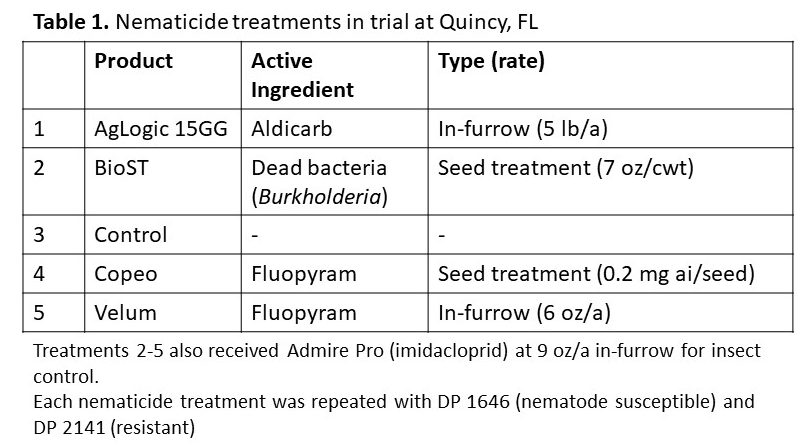
–
Resistant cultivars greatly reduced reniform nematode infection in cotton
For any crop, the level of resistance from “resistant” cultivars can vary, so it is important to check this. To do this, reniform nematode eggs on cotton roots (indicating infection and reproduction of the pest) were counted midseason (6 weeks after planting). For most treatments, early season protection against nematode infection are also key to boosting yield.
As shown in Figure 1 below, DP 2141NR resistant cultivar was very effective at reducing midseason reniform nematode root infestation. Nematicides were generally not as effective as reistance, but AgLogic 15GG was generally superior to other nematicides. Phytogen resistant cultivars (411 and 443) were also effective in their trials (Figure 2). While the data is not shown here, all resistant cultivars also generally reduced reniform nematode soil abundances at harvest, showing the cultivars may provided some carryover nematode control for the next season.
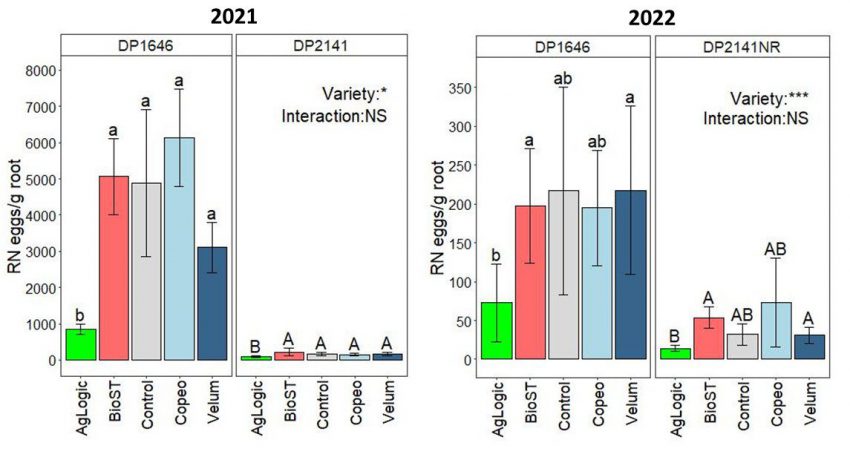
Figure 1. From trial with nematicides and Deltapine cultivars: Reniform nematode infestation in cotton roots (reniform nematode eggs/gram root) in 2021 and 2022 at midseason (6 weeks after planting). Means with the same letter are not significantly different. “*” indicates DP 2141NR significantly reduced RN infection both years.
–
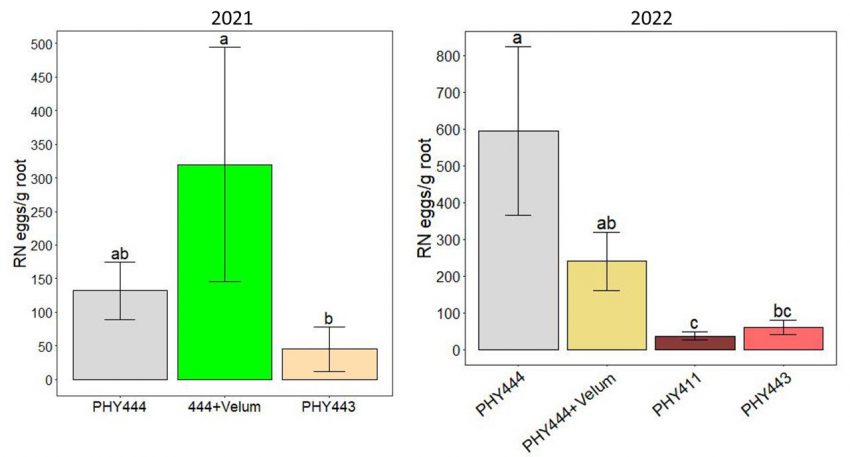
Figure 2. From trial with Phytogen cultivars: Reniform nematode infestation in cotton roots (reniform nematode eggs/gram root) in 2021 and 2022 at midseason (6 weeks after planting). Means with the same letter are not significantly different.
–
Yield Data
DP2141NR had slightly less yield than DP1646 in 2021, but much greater yield than 1646 in 2022 (Figure 3). Nematicides did not have a substantial influence on yield in either season. Canopy size was much greater for 2141NR than 1646 each year and there seemed to be more hardlock in the full, moist canopy of 2141NR in 2021, which may partially account for reduced yield. Specialists in other states have also reported somewhat inconsistent yield returns from DP 2141NR versus DP 1646, so this may just reflect its agronomic potential.
Phytogen resistant cultivars (443 and 411) consistently had substantially greater yield than the susceptible cultivar (PHY 444), with or without Velum (Figure 4). In 2022, the Phytogen and Deltapine trials were in the same field and yields were roughly comparable. In 2021, the trials were in different fields so they cannot be compared, even informally.
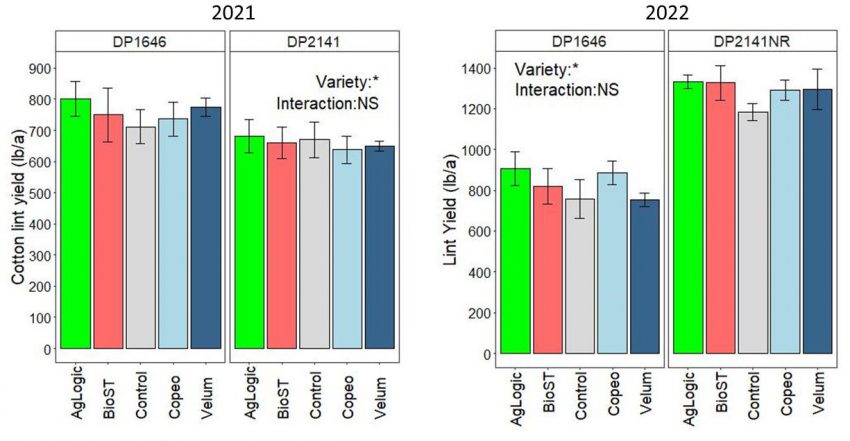
Figure 3. From trial with nematicides and Deltapine cultivars: Cotton lint yield in 2021 and 2022. Nematicides did not significantly affect yield. “*” indicates cultivar significantly affected yield each year.
–
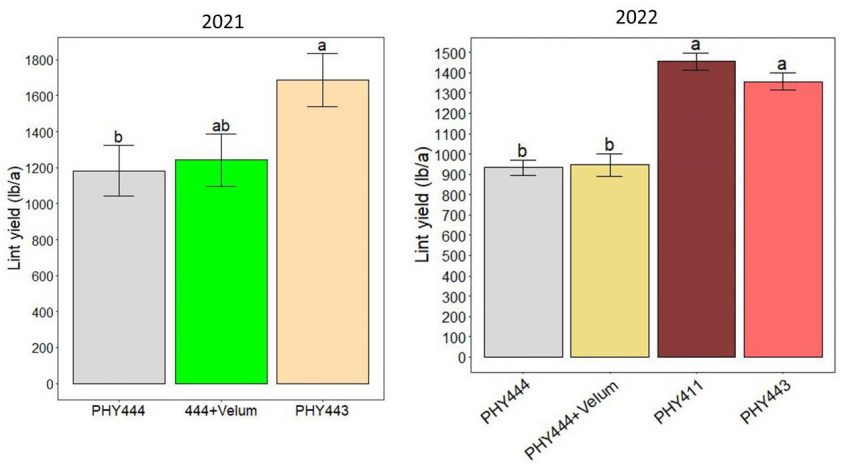
Figure 4. From trial with Phytogen cultivars: Cotton lint yield in 2021 and 2022. Means with the same letter are not significantly different.
–
Resistant cultivars increased income relative to susceptible cultivar without nematicide
For each trial, I calculated basic economic returns with the susceptible cultivar without nematicide as the baseline. This was done by calculating the revenue from cotton lint based on yield and $0.80/lb yield. Product costs were subtracted from revenue to get net income for each plot/treatment. Product costs ranged from $9-$15/acre for seed treatments, $30-$45/acre for in-furrow nematicides and a $20/acre premium for PHY 411 or 443 relative to PHY 444 for herbicide traits. Based on those figures, difference in net income per acre for each treatment relative to the baseline treatment was calculated.
Generally, changes in income relative to baseline were similar to trends for yield. In 2021, DP2141NR decreased income per acre by a range of $20-$100/acre depending on nematicide treatment (Figure 5). In contrast, in 2022, DP2141NR substantially increased income relative to untreated DP 1646, with increases ranging $350-$430/acre depending on nematicide treatment. Based on the results of this trial, a grower would have been substantially ahead by growing DP 2141NR in both years, despite a loss in 2021. Obviously, more consistent cultivar performance or the ability to predict conditions where 2141NR will provide a return would be even more profitable.
PHY 443 consistently boosted income compared with PHY 444 with or without Velum (Figure 6) and PHY411 boosted yield when it was tested in 2022. In fields with severe reniform nematode pressure, Phytogen resistant cultivars perform well and have consistently provided a return on investment.
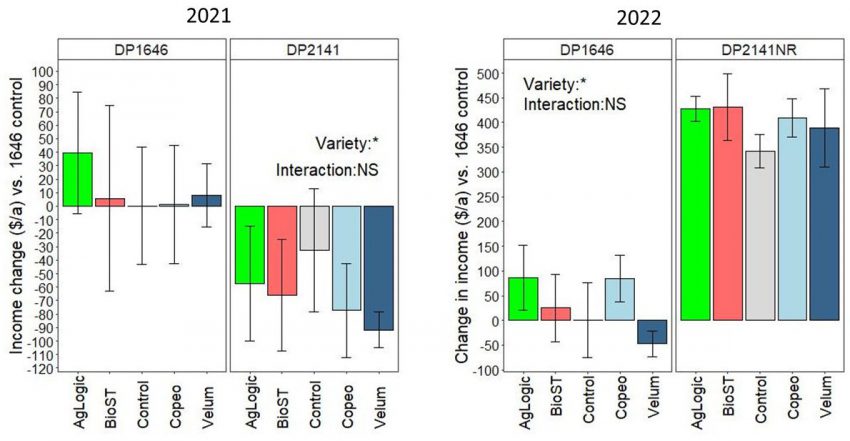
Figure 5. From trial with nematicides and Deltapine cultivars: Cotton lint yield in 2021 and 2022. Nematicides did not significantly affect income. “*” indicates variety significantly affected income each year. Income change ($/acre) is relative to mean for DP 1646 without nematicide.
–
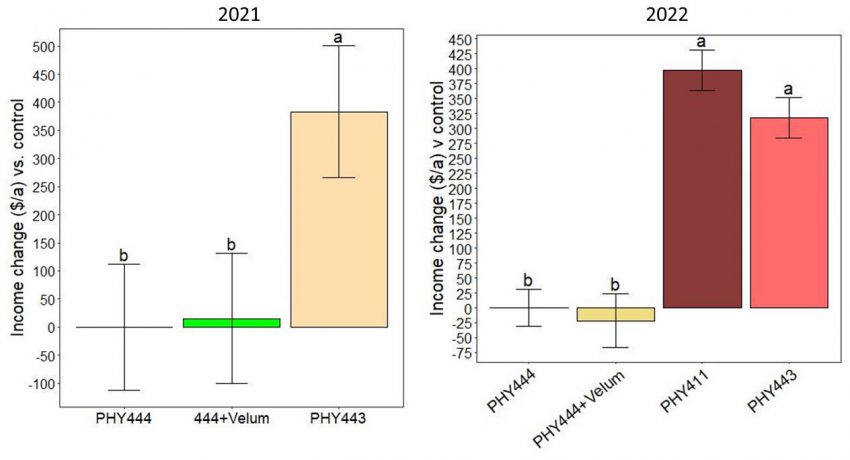
Figure 6. From trial with Phytogen cultivars: Cotton lint yield in 2021 and 2022. Means with the same letter are not significantly different. Income change ($/acre) is relative to mean for PHY 444 without nematicide.
–
Takeaway points and action items
- New dual-resistant cultivars are effective at reducing reniform nematode infection and generally boost yield.
- Under substantial reniform nematode pressure, resistant cultivars were more effective for managing nematodes and boosting yield than nematicide application in combination with a susceptible cultivar.
- If you have fields with reniform nematode infestation, try a resistant cultivar. As with any new practice, testing a resistant cultivar on limited acreage relative to your current cultivar and nematicide is a good starting point.
- If using a susceptible cultivar, growers may benefit from AgLogic 15GG application on reniform nematode fields as this was generally the most effective nematicide for managing that pest. To use AgLogic 15GG, growers must be set up for granular application and obtain a use permit as described in this publication: How to Obtain an Aldicarb Application Permit for Florida Cotton or Peanut.
For more information on nematode management in cotton, use the following publication link: Management of Plant-Parasitic Nematodes in Florida Cotton Production
- Salibro: A Recently-Registered Conventional Nematicide for Select Horticulture Crops - March 7, 2025
- What Cotton Cultivars have Resistance or Tolerance to Southern Root-knot and Reniform Nematode? - February 28, 2025
- How Well Do Root-Knot Nematode Resistant Peanut Cultivars Perform in Florida? - February 14, 2025
